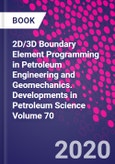2D/3D Boundary Element Programming in Petroleum Engineering and Geomechanics, Volume 72, is designed to make it easy for researchers, engineers and students to begin writing boundary element programs. This reference covers the fundamentals, theoretical developments, programming and applications. Both fluid flow through porous media and structural problems are used for coding exercises. Included computer programs may be used as starting codes; after modifications, they can be applied to real world problems. The book covers topics around mesh generation, 3D boundary element coding, and interface coding for controlling mesh generation, and plotting results.
Please Note: This is an On Demand product, delivery may take up to 11 working days after payment has been received.
Table of Contents
Fundamentals 1. Fundamental elasticity equations 2. Flow through porous media 3. Tensor notation or index notation 4. Fundamental solutions
Theoretical development 5. Boundary element methods 6. Discretization of integral equations 7. Numerical integration 8. System of linear equations 9. Discretization of the system of equations for fluid flow through porous media
Programing 10. 2D structure code (Direct BEM) with stiffness matrix without numerical integration 11. 2D Structure code (Direct BEM) with stiffness matrix with numerical integration 12. 2D Discontinuous Boundary Element Method (DDM) suitable for crack problems 13. 2D transient flow program using time dependent fundamental solution 14. 3D boundary element code (Direct BEM) for solid elasticity problems 15. Analytical 3D displacement discontinuous method: Stress shadow induced by movement of fault planes and fracture opening 16. 3D static fracture model using the dual boundary element method���� 17. 3D fracture propagation code coupled with 2D finite element flow and 3D fracture code (DDM) Application 18. Interface program, and mesh generation program








